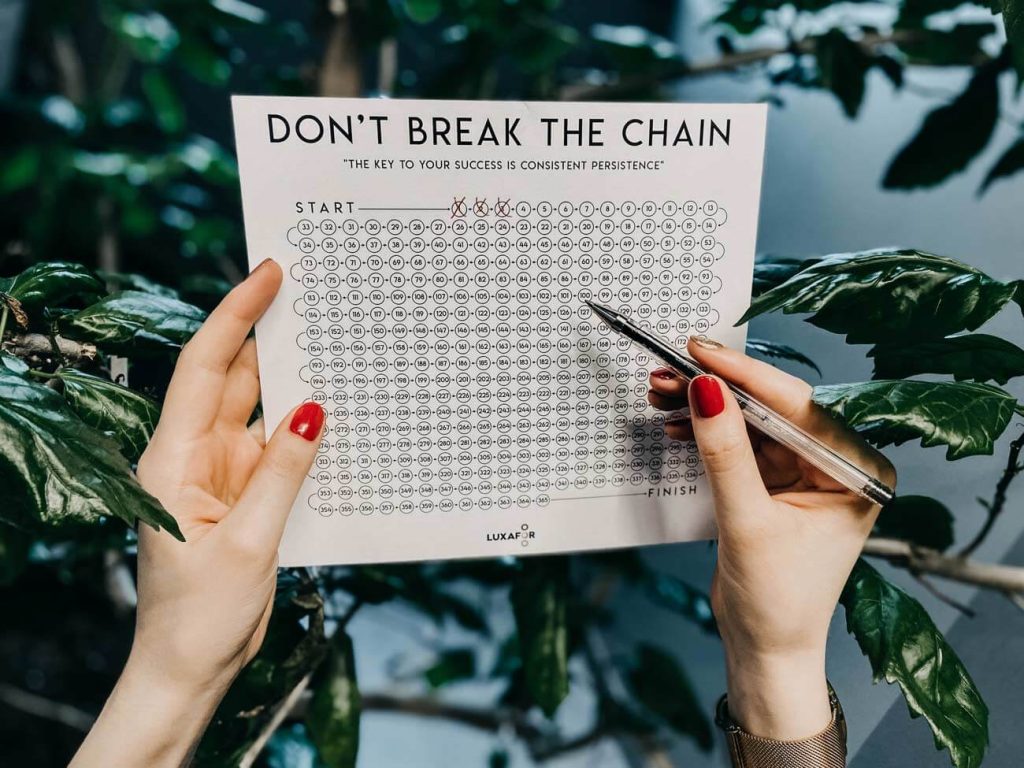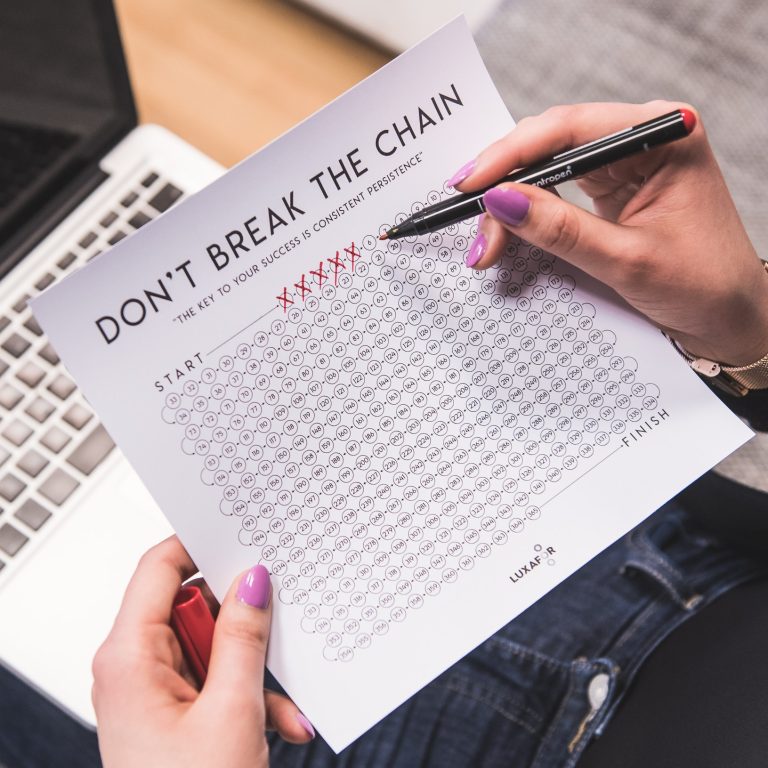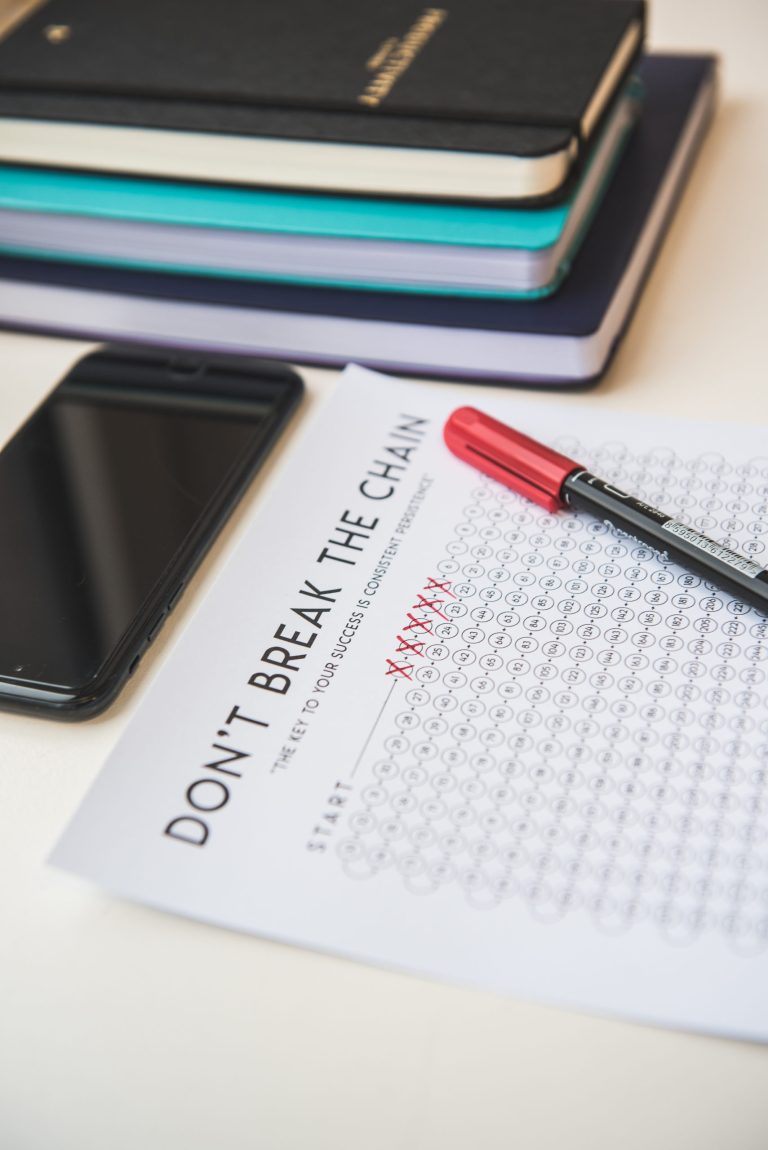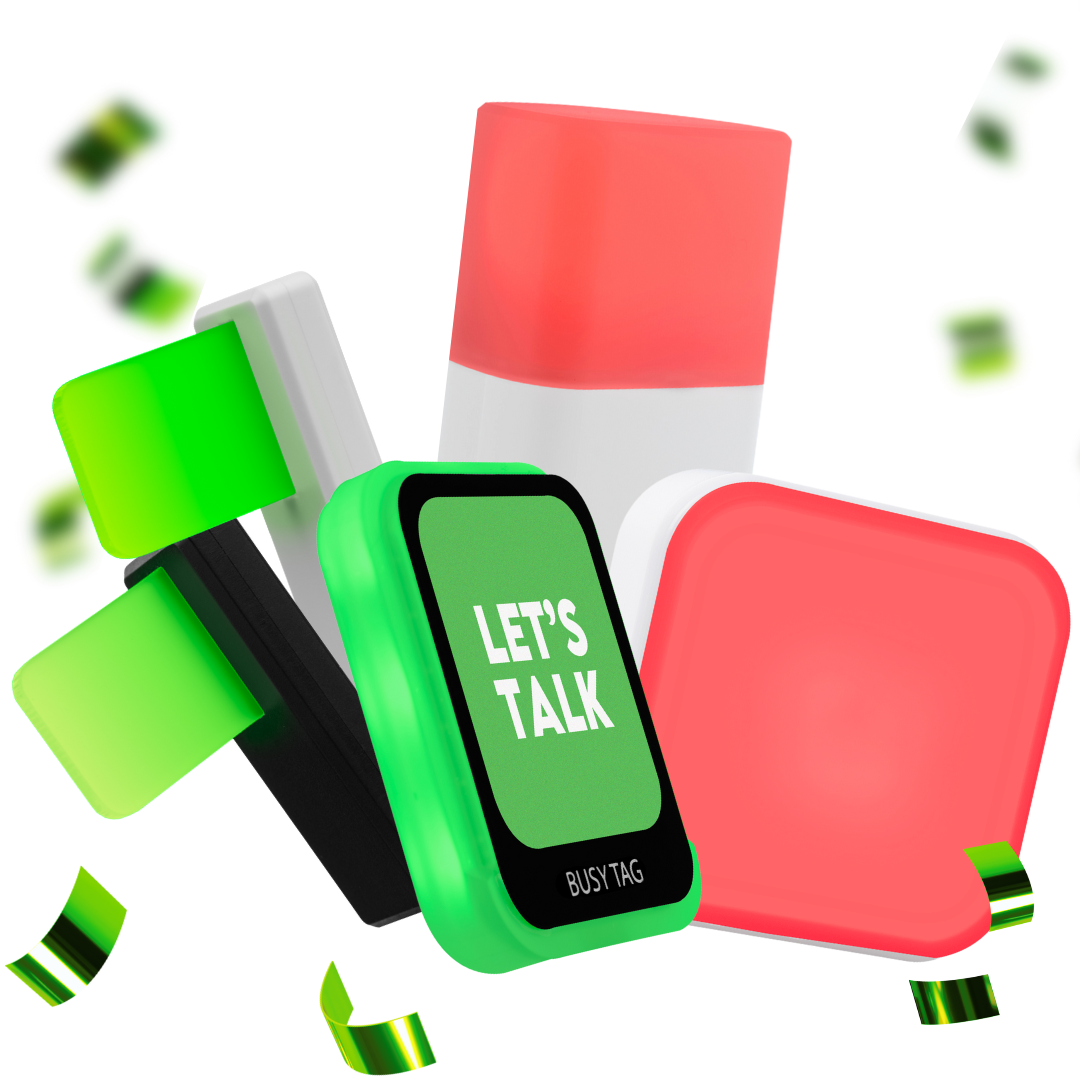Don't Break The Chain: Explained & PDF Calendar Template Download
- Updated on: February 4, 2025
Kristian, the CEO of Luxafor company, is sharing his experience with one genius habit-building technique, how to tackle it, and why it is the key to success in any industry. All in a simple, Q&A manner of explaining things.
At Luxafor, we’re more than just productivity gadget manufacturers and industry specialists. We’re a team of passionate experts dedicated to providing you with actionable tips, proven techniques, and insightful information – all designed to elevate your efficiency and propel you towards success. We curate a wealth of knowledge, from time management strategies and habit-building hacks to the latest research and industry trends in productivity.
What is the Don't Break The Chain technique?
This technique has a great story behind it: Years ago, when software developer Brad Isaac was performing stand-up at open mic nights, he received the best advice ever from the already-famous comedian Jerry Seinfeld.
The advice was to simply make one specific and simple goal for yourself. And every day you meet your goal, mark that day out on a 365-day calendar with a big red X. After a few days, you’ll get a nice chain going.
The idea is not to break the chain.
This beautifully simple mental trick works surprisingly well. Looking at your past accomplishments provides motivation to keep going, and helps you stay focused on the present. It removes the daily decisions you subconsciously make: do I have time to do it? do I feel like it? Should I bother today? Just do it! Make it a part of your daily routine, and then don’t break the chain!
What can I use Don't Break The Chain for?
You can use don’t break the chain tool for literally any skill you want to teach yourself or a new habit you want to form, where you can practice a little bit each day. Some examples include:
- Writing
- Exercise
- Learning a language
- Household cleaning/chores
- Setting limits
- Reading
- Meditation / Mindfulness
- Drawing
- Music / Practicing an instrument
- Limiting sugar intake etc.
The possibilities are endless, really. This technique’s main point is to stay on track and keep yourself accountable. I found for this to be the ultimate way to fix my procrastination problem on both smaller and bigger goals.

Source: Unsplash
How do I use Don't Break The Chain effectively? What kind of goals should I set?
The idea is to do something each day. Set a realistic goal. Something you can do even on days when you’re busy, or don’t feel like it, or are out of ideas.
If you’re writing, your goal could be to write something each day, anything. Or even better: write 500 words each day. If you’re drawing, do at least one sketch per day.
For exercise, just make it to the gym and do 5 minutes of something. Or try to do 30 minutes of exercise daily, starting with 30 minutes of stretching in the mornings for the first month and gradually building the strength of habit to do more intense workouts.
Your real goal is to form and keep a habit and to keep your mind engaged in your activity. Simply engaging your mind in your activity each day does wonder.
Download "Don't break the chain" calendar PDF
Of course, some days you can and should do more — you should try to push yourself — but by setting a goal you can do each day, you keep the habit, which is the most important aspect of the Don’t Break The Chain technique.
You can’t practice something every day and not get better.

Source: Unsplash
Why does such a simple technique work?
I strongly agree with “One Percent Solution” — the concept by Allan Weiss that if you aim to improve yourself (or your business) by 1% each day, in only 70 days you’ll be twice as good as you are now. This begins with small steps. Pick one thing you want to get better at, and do it every day. Mark a big red X on that day. And don’t break the chain.
If you’re still skeptical about this concept, I encourage you to use a simple interest calculator online like the one shown below. Put in “1” for “Current Principle,” nothing for “Annual Addition,” “70” for “Years to Grow,” and “1” for “Interest Rate.” Leave the rate of compounding as it is, and then hit calculate.
As shown below, the result is just a bit more than “2.” It doesn’t matter that “years” rather than “days” are the unit of measure here. The point is that the original amount is compounded 70 times doubling the future value. You do the math of what can happen in 365 days with a small daily investment of your time!
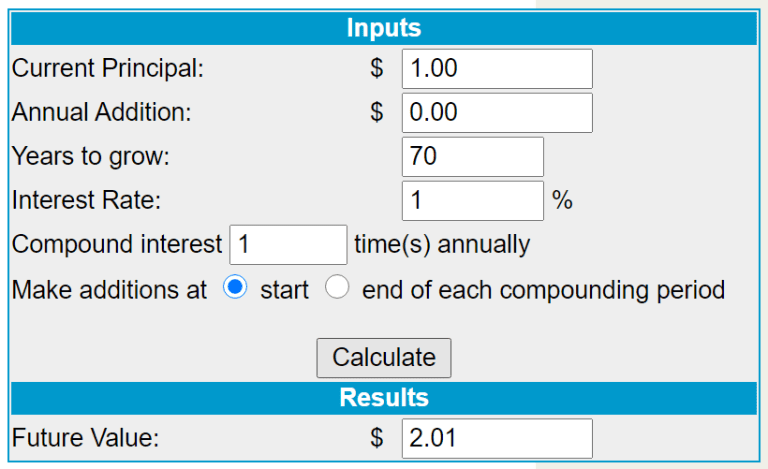
Can I ever take a day off?
Don’t Break The Chain is a technique you can use for motivation, but ultimately, you make your own rules. Sometimes you may find yourself burnt out, and the best thing is to take a day or weekend off.
“If you catch yourself getting burnt out, and you feel like taking a day off is the best way to help, by all means, do so.”
To give you an example, I first started using this technique for building a habit to exercise every day when I woke up. When a month passed, I realized working out every morning was too much, even though I did very light exercise at first. So I tweaked my own rules: my chain must go unbroken for 6 days straight and I could leave Sundays blank – to let my body recover. I don’t consider this breaking the chain, as long as the break is consistent, this will definitely work for you as well.
You could also put a red R on that day for recovery if you don’t feel like having a blank space due to physical constraints. Of course, if you can use this technique for something that doesn’t require any days off due to burnout, then do it!
You could also put a red R on that day for recovery if you don’t feel like having a blank space due to physical constraints. Of course, if you can use this technique for something that doesn’t require any days off due to burnout, then do it!
Maximize the effect of this strategy by setting realistic and specific goals. It’s much better to choose a goal to “write 300 words each day” over a goal of “writing each day”. The more specific you’ll be with formulating your goal, the less likely you’ll be to procrastinate on it and break the chain.
Make your own rules, but also remember to re-examine your rules periodically to decide whether they’re working or not.

Source: Unsplash
What about taking weekends off?
Ultimately it depends on your goal and your own rules. I would highly recommend avoiding “weekends off’ whenever you can, as they have a tendency to grow into “forever off”.
Personally, I had set goals for more creative skills in the past two years. What I found was these skills benefited from practice every day, including the weekends, since I kept my brain engaged. For physical goals such as exercise, as mentioned before, it’s good to have recovery days anyways, and taking weekends off may work better in some schedules or routines.
A great incentive not to break the chain would be to calculate how much time you’d lose in a year by skipping just two days a week every week for the whole year. That’s the whole 8 days lost in a month. That’s 96 days a year! 96 days of potential growth totally wasted.
Why would you do such a thing to yourself? Why would you stop the rate at which you can learn? Just don’t break the chain!
So if you truly want to build a great habit or learn a new skill, stick to it daily and you’ll find yourself evolving quicker than you ever thought was possible!
Source: Luxafor
What about those days when I just don't feel like it? Do I get a "vacation"?
Well, you must commit to building a habit, which sometimes means doing things you don’t feel like at first. Trust me, it will become easier to “feel like it” once you’re on it. The most difficult part is to start.
But we’re all human, and I get it. It’s unrealistic to expect yourself to work on all your goals every day for the rest of your life. Sometimes you get sick and sometimes you need a break. That said, it just feels wrong to put an X on a day when you did nothing. It also feels wrong to break the chain for a reason beyond your control or for a hard-earned vacation. If you think of this process like a mini-job, however, the solution is simple: time off limits.
When you’re sick and can’t perform your duties, put an S instead of an X on that day. If you’re on vacation and cannot or do not want to perform your duties, put a V on that day. How many days do you get off? I just use the same rules as my job: three weeks per year including sick days.
You can follow the same benefits you get at work or just use the standard allotment: 15 vacation days and six sick days. That’s 21 days off you’re allowed in the whole year. Way less than the 96 days mentioned earlier, if you’d allow yourself the luxury and pain of taking every weekend off.
Remember, these are the boundaries I have set for myself, you can always tweak and find the formula that works the best for you. You only have to remember that you started this to build a daily habit or practice a skill every day. Why steal these precious opportunities to grow from yourself? Make sure you don’t break the chain – limit the total amount of days off.

Source: Unsplash
What's different from using a regular calendar or my phone?
Firstly, your phone is already such a distraction to your health that I wouldn’t recommend adding a new one with an extra notification load.
Secondly, your average calendars have a huge problem: if you start your new habit or task later in the year, it creates a huge problem. The calendar will forever remain blank up until the day you decided to start your new habit.
That blank block can be extremely demotivating (trust me, I know, as that is exactly how my first attempt at the Don’t Break The Chain technique failed). So get a calendar that has the first day of your new habit-building chain right at the top, and then don’t stop!
You absolutely can use any other way but a specific Don’t Break The Chain calendar for this. Though I can almost guarantee that your motivation to proceed will not last past the first 7 days. That’s what happened to me in my first trial to tackle this technique.
Also, I don’t feel as much satisfaction checking something off on an app as much as I do, when physically crossing a day off with a big, fat, red X. And it is so much easier to hold yourself accountable when the chain is just there in front of your eyes. Something about the simplicity of it helps a lot.
And remember that this technique is all about finding what works best for you.
Source: Luxafor
Where should I put such a calendar for maximum motivation?
It depends, but the main don’t break the chain rule to follow is to put it somewhere you’ll see it and it will remind you of your goals, as your brain works through the power of association and visualization.
If you habitually do a certain task in a certain place then your brain will begin to associate the physical and psychological states you’re in with that specific location.
For example, when you lay in bed, you typically feel tired even if you’ve only been awake for a few hours. When you go to a gym, you immediately get a burst of energy even if you were tired before. Use this to your advantage and create specific location-based anchors for important tasks – place the calendar in specific locations.
Download "Don't break the chain" calendar PDF
The way to find the best location for such a calendar is to follow these simple steps:
- Figure where your chosen activity/ task/ habit/ would mainly take place (I like to divide this into simple sections home/ office/ gym/ everywhere)
- Once you know where the activity will take place, figure out the best location within that space to remind you of your set goals.
For example, if you decide to build a habit to go to the gym every day, the activity will take place in the gym. So for exercise goals, you could put the calendar by the entrance door of your house, and a mini-version in your gym bag to make sure you don’t break the chain and keep up the good habits.
If you wish to build a habit to write 200 words every day, the activity most likely will take place in the office. For such skill-building that will most likely happen in the workplace, put one on your desk or just pop a mini-version in your planner.
If you decide to build a habit of no TV after 8 PM every day, it is highly likely you’ll practice it at home. So to hold yourself accountable, place the calendar in the room where your TV is.
Ultimately the main rule is to place it somewhere where it’ll be in front of your eyes and bug you if it had a blank space on it breaking the chain.
Source: Luxafor
So where can I get a "Don't break the chain" calendar?
Do you want to build and maintain new habits? Get your free PDF version of the Don't Break The Chain calendar and start today!
Frequently Asked Questions
It's a visual habit-building technique that relies on building a streak of completing your desired habit daily. You track your progress on a calendar or chart by marking each day you complete the habit.
- Increased Consistency: The visual reminder encourages you to stick with your habit daily.
- Positive Reinforcement: Seeing a growing chain is motivating and reinforces the desired behavior.
- Focus on Daily Action: Instead of overwhelming goals, it focuses on the smaller, achievable daily step.
- Habit Formation: Over time, consistent repetition helps solidify the desired behavior as a habit.
Don't despair! Restart your chain with a positive attitude. The key is to get back on track as soon as possible.
Describe the Don't Break the Chain method in short?
Author

Martins Z.
Enthusiastic writer with an interest for all things related to productivity, tech, communication, and personal improvement.

